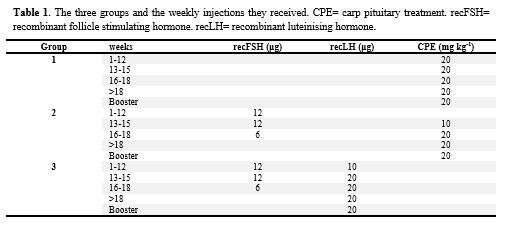FIRST EUROPEAN EEL LARVAE PRODUCED USING RECOMBINANT FSH AND LH – IN VIVO AND IN VITRO EFFECTS ON OOCYTE MATURATION AND REPRODUCTIVE SUCCESS
Introduction
The current protocol for the induced maturation of female European eel consists of long-term weekly injections with carp or salmon pituitary extract (C/S PE) to induce oocyte growth, a single booster PE injection and a single 17α,20β-dihydroxy-4-pregnen-3-one (DHP) injection to induce oocyte maturation and ovulation. However, egg quality is often poor and when larvae are produced they die before exogenous feeding. This study describes the third in vivo experiment in a series of ongoing experiments in our lab aiming to replace PE treatment by highly stable eel-specific recombinant gonadotropins (Peñaranda et al, 2018) in order to improve gamete quality and reproductive success. In an earlier study, we have been able to fully mature European eel and strip good quality eggs by treatment with recombinant gonadotropins but no larvae hatched (Palstra et al., 2019). In this third in vivo experiment, we have stimulated the sexual maturation by treatment with (i) CPE, (ii) recombinant FSH (recFSH) followed by CPE, and (iii) recFSH followed by recombinant LH (recLH), and compared the effects on reproductive success. Additionally, to focus the study on dose and effects of recombinant LH in boosting oocyte maturation, we have set-up an in vitro system and compared recLH with CPE as control.
Materials and methods
For the in vivo trial, experimental eels were feminised, subjected to simulated migration (Mes et al., 2016) and treated with a steroid implant (Thomson-Laing et al., 2019) containing 17-methyltestosterone and E2. Thirty eels were then divided over three groups and treated as described in Table 1. Oocyte maturation was boostered by injecting CPE or by injecting recLH (Table 1). Ovulation for eels in all groups was induced by injecting DHP (2 mg kg-1). Eels were stripped for eggs which were fertilised and reared.
For the in vitro trial, experimental eels were feminised, subjected to simulated migration and treated with a steroid implant. Ten females were weekly injected with CPE to induce oocyte growth. Just before the CPE booster, ovarian tissue (~5g) was retrieved and kept on ice-cold culture medium. After the oocytes had been dispersed by pipetting the ovarian pieces, approximately 60 oocytes were placed per well in triplicate per treatment in a 24-well culture containing 1mL of hormone-free media and 1mL medium supplemented with the treatment (CPE: 1.25, 12.5 and 125 ug/mL; RecLh: 10, 100, 1000 ng/mL). Just before incubating, oocytes were sampled for microscopy, histology, RTPCR and medium analysis for DHP measurements. Culture plates were then incubated at 16°C for 12 and 18h. After incubation, oocytes were sampled for the same purposes.
Results and discussion
Of the ten eels that were treated with CPE in vivo, one eel died during treatment, seven matured after 7-9 weeks, two matured after 12-13 weeks. Four of these eels could be stripped and two eels gave larvae that survived up to 6 and 18 days post hatch (Table 2). Of the ten eels that were treated with recFSH and CPE, four eels died during treatment, others matured much later after 15-22 weeks. Two of these eels could be stripped and one eel gave larvae (Table 2). Of the ten eels that were treated with recFSH and recLH, three eels died during maturation, others also matured after 15-22 weeks. Three eels could be stripped and one eel gave larvae (Table 2). Three eels that had been treated with recFSH died after DHP injection with GSI values of 75, 77 and 80 which are enormous in comparison with the regular average values of 40-50 after CPE treatment.
From the in vitro trial, analyses are currently being executed but results will be presented.
Acknowledgements: The authors thank the DUPAN foundation; The Dutch Ministry of Economic Affairs and the European Union, European Maritime and Fisheries Fund, and partners of the international EELRIC consortium (www.eelric.eu).
References
Peñaranda, D.S., Gallego, V., Rozenfeld, C., Herranz-Jusdado, J.G., Pérez, L., Gómez, A., Giménez, I., Asturiano, J.F., 2018. Using specific recombinant gonadotropins to induce spermatogenesis and spermiation in the European eel (Anguilla anguilla). Theriogenology 107, 6–20.
Palstra, A.P., Giménez Nebot, I., Jéhannet, P., Lokman, P.M., Swinkels, W., Heinsbroek, L.T.N., 2019. Testing recombinant gonadotropins for the propagation of European eel (Anguilla anguilla), pretreated by feminization, simulated migration and steroid implants. Aquaculture Europe, October 7-10, Berlin (Germany).
Mes, D., Dirks, R.P., Palstra, A.P., 2016. Simulated migration under mimicked photothermal conditions enhances sexual maturation of farmed European eel (Anguilla anguilla). Aquaculture 452, 367–372.
Thomson-Laing, G., Damsteegt, E.L., Nagata, J., Ijiri, S., Adachi, S., Todo, T., Hiramatsu, N., Lokman, P.M., 2019. Synergistic effects od estradiol and 11-ketotestosterone on vitellogenin physiology in the shortfinned eel (Anguilla australis). Biol. Reprod. 100, 1319–1332.

